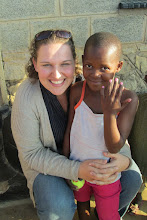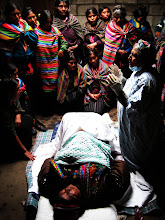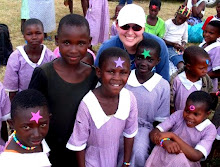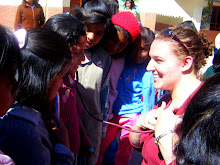My little village in the Maluti Mountains is full of people and places that make it extra special. Here are just a few of the memorable faces and places that make Ha Selomo feel like home...
And just across the dirt road from Ntate Selomo's place, is 'Me Mantebo's house. If Ntate Selomo is the quintessential village man, then 'Me is the typical elderly nkhono or grandmother. When the first Peace Corps Volunteer came to live in Ha Selomo in the 80's, 'Me was, ausi Puleng's, host mother. 'Me Mantebo's now lives with her young granddaughter, Lebohang (one of my Form B students), who seems a great comfort and help to 'Me in her old age. Last winter, I found myself wandering around Ha Selomo one afternoon and saw 'Me Mantebo and some other elderly women sitting on a giant blue tarp on the ground in front of her old crumbling rondaval. When I stopped to greet them, they insisted I sit down and help with the work. The were going through a process called khotola, where you separate the dried kernels off an ear of corn in preparation for grinding it into papa. 'Me Mantebo patiently watched, with much amusement, as I bloodied my knuckles inexpertly scraping the maize ear across a roughened rock. I was horrible at it, and the occasional roaming child who sat down to help, always put my fledgling attempts to shame. 'Me, however, seemed so grateful for the afternoon we spent together and every time I visit her now she can't resist but tease me by asking if I've been practicing khotola. Ha!
If you stay on the dirt road into lower Ha Selomo, you'll hit a T junction in the road. Go left and it takes you to Ha Makhoahla, then Ha Sebophe, and finally on to Linakeng. Go right and you pass a scattering of little villages that fall under Ha Selomo, such as Motie. On this side of village, the road skirts around the base of a giant plateau, atop which lies Ha Selomo holimo or upper Ha Selomo. Villagers that live in upper Ha Selomo walk on foot, or haul supplies atop donkeys, up a winding path, that occasionally moves along a steep, rock covered slope. I quite frequently thank God that I DONT live in upper Ha Selomo. Ha! But if you stay on the dirt road below the ridge, eventually you'll reach Ha Leboea, where my fellow PCV, Brendan or Lebohang, lives. The T junction in lower Ha Selomo, sometimes called lebenkaleng meaning "the shops", is the life of Ha Selomo. At the corner is the largest shopong in village, which we call Rueban's shop, after the young Indian guy who owns it. The shop is home to a very noisy and attention loving cat, Penny, and is run by Ausi Tsepang and Ntate Dan. It's the epicenter of village life, and always full of friendly faces coming to and from.
Across the dirt road sits a perpetual line of weary old khombis, or bush taxis. This junction in Ha Selomo is the turnaround point for taxis to all the villages down my dirt road, Unlucky villagers who live even further down the dirt road (like my friend Brendan) have to switch taxis or, when no taxis are available (which happens quite often!) start walking! This is where 'Me cooks and sells maquena out of her roadside fruit stand. In the early mornings, this part of village fills with the smell of bread dough being deep fried in a big metal basin over an open fire. When dipped in sugar and cinnamon, her maquenas could surpass even Krispy Kreme for deliciousness.
On my way home from school in the afternoons, I often take a little dirt path that breaks off the main road just beside 'Me's fruit stand. As I pass underneath the beautiful old oak tree in the center of village (one that two village elders once told me was 250 years old, making it older than Lesotho itself), I pass by the local councilman's office. The secretary 'Me Mamathabi (whose little boy, Mathabi, I teach in Form A) is often sitting outside soaking up the sun, and always gives a loud shout and happy wave when I pass. When I first arrived in village, 'Me and I would sit outside her office with an inevitable gathering of Bo-me and teach me Sesotho. Later in that first summer I was in Ha Selomo, I got recruited into helping the local women resmear the building for the councilman's office.Now every time I pass the office and see the encroaching cracks making their way across the mud walls, I smile and think that it won't belong before Me shows up at my door telling me it's time to smear again!
The path that leads to my house is always lined with the happy chatter of Bo-me sitting around the pump waiting for water, or children running around the football field that borders my family's compound. As I walk down the dirt path, I pass the agriculture compound on my right, where my neighbor works in the village piggery. On my left, sits 'Me Mankapisi's house. Me is an interesting character... Apart from being inexplicably IN LOVE with me, she is also the local sagoma (also called an nagaoka in Sesotho) or traditional healer. Above her compound, atop a large stick flagpole, hangs a traditional broom attached to a sickle? This announces that Me practices traditional Basotho medicine. Her house doesn't look so different from the other brick homes of villagers, but beside it sits a small traditional rondaval, that has such a low door you have to stoop or crawl to enter. This is where villagers come if they suspect they have an ailment related to witchcraft. For being the local traditional healer, Me Mankapisi's is about exactly what you'd expect. She plump, short, and perpetually barefooted- snow or shine, town or village. She wears rightly beaded jewelry and a bright red and purple wrap, that gives her an air of royalty. She hilariously outspoken and has a loud boisterous laugh that comes out anytime I say.... Well, anything!
Me Mankapisi's house sits on one corner of the village football field. Down the length of the field, sits my house at the adjacent corner. Just next door to me, lives 'Me Mamolefie, and her gaggle of kids. With seven living children, she seems the quintessential mother figure. Several are grown and married, while others are still in diapers. Her young ones, Makhoro, Mohalaka, and Nthatisi, are my constant companions around village and at my house, while her older girls Keke and Nthabiseng frequently visit for new magazines and help with math homework. I absolutely adore all of them.
Across the football field from me, along the dirt road to Ha Sebophe, lives Ntate Taole, the local councilman and preacher. He and his wife, Me Mamatsane are absolutely amazing, and I have (as with most of the families in Ha Selomo) taught a smattering of their children in school. On the same compound as his house sits a little one-roomed brick, tin-roofed building, that serves as a church. Here, every Sunday, a small collection of youth and villagers from lower Ha Selomo gather to worship. Hopolang, and her group of youth ladies lead the congregation in accapela songs that make me wonder why anyone ever thought a piano, organ, or band were necessary. Their call and response traditional hymns fill this tiny, empty, tin-roofed room and never ceases to give me shivers. The church looks out onto the beautiful vista of the Linakeng Valley, with the Maluti Mountains rising in the background. On the ridge, just across a hillside of maize fields, you can barely see my school, with it's tin roofs and blue doors, peaking out of the trees that surround it.
There have been a hundred other people, places, and memories. Sounds and smells I know associate with home. And most importantly, is the unwavering sense of community that fills this place. Children grow up as siblings, running around wild without fear or even shoes. Ha! Occasionally the air is punctuated by the sound of a taxi horn, but you're more likely to hear the gentle clanging of cattle bells or the voice of a mother calling her kids in from play. Things are peaceful here. I've loved this village immensely.
With Love from Lesotho... Mary E.






No comments:
Post a Comment